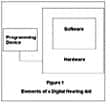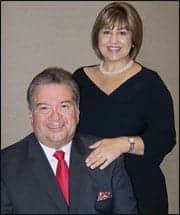Of the many frustrating clinical scenarios faced daily by audiologists, one of the most exasperating can be the patient with hearing loss who is not aware of (or will not acknowledge) his/her own hearing handicap. Each of us can likely recall particular counseling sessions in our career which have gone poorly with this type of patient. An exasperating exercise, we sometimes find ourselves virtually having to convince patients that they have a hearing loss.
Helping patients to become aware of the (oftentimes) subtle segmental and suprasegmental cues being missed because of their hearing loss is difficult even with an attentive patient. It can be an especially frustrating task with, for example, the patient who feels as though they have been pressured into the examination by family members. Audiologists quickly learn that the primary goal of this type of patient is to convince everyone they don’t have a problem. It is with this type of patient we frequently fail as counselors due, in part, to a lack of anything beyond X’s and O’s to show them.
Interactive Audiological Evaluations
The field of Audiology has a wide array of diagnostic tools, yet unfortunately has developed few counseling tools regarding the effect of hearing loss on speech perception beyond the Speech Banana or “Count the Dots” method.1 What we have been lacking is a method to make our diagnostic process interactive in such a way that patients learn about their handicap, not only from post-evaluative counseling, but from and during the diagnostic process itself.
Developing a diagnostic process which is interactive means having some self-assessment method in place during diagnostics whereby patients can make informed judgments concerning their own test performance. To illustrate, consider the traditional optimetric examination. Most of us enter into the visual examination aware that 20/20 is the benchmark for normal vision. Printed boldly beside each line that we are instructed to read during the eye examination is the predetermined visual acuity level necessary to read that size print. As we proceed through the visual examination, it is immediately apparent which lines we can and cannot read.
Thus we learn for ourselves during the examination whether we are successful at the 20/20 level, the 20/40 level, or perhaps the 20/200 level. Because of this small interactive step, we don’t need to wait until the completion of the examination for the optometrist to inform us as to whether or not there are problems with our vision.
Visual Speech Discrimination (VSD)
Providing diagnostic tools which allow patients to assess their own performance in real time may prove useful in a number of ways. It may prove especially useful in helping the patient develop the necessary internal motivation to successfully get involved with their own rehabilitation. In the audiology examination, the Speech Discrimination Test may be one tool which offers an expedient method for accomplishing both diagnostics and teaching. (The authors recognize that, in the strictest sense, the “Speech Discrimination Test” might best be referred to as the “Speech Recognition Test” due to its open-set response)
In a traditional audiological examination, speech discrimination results are generally the first indicator of the degree of handicap being caused by a particular audiometric configuration. An inherent problem with the testing procedure in the way that it is typically administered is that only the audiologist is aware of the errors occurring during testing.2 Patients proceed through the test oblivious to their errors because they are simply repeating the words (they think) they hear. In fact, they can be quite incredulous when subsequently informed that they scored below the normal range.
With this in mind, it seems plausible that post-evaluative discussions with patients will be enhanced by incorporating into the Speech Discrimination Test a method whereby patients can observe the errors they are making as they actually occur. By establishing a test session wherein the patient and the audiologist can jointly observe areas of auditory perceptual breakdown, a team approach to developing and implementing rehabilitative strategies can be more easily initiated.
Visual Speech Discrimination (VSD) incorporates the use of one computer and two monitors into the test environment. On the clinician’s side of the test booth is a PC with dual-monitor output (ie, a Y-cord leading to the two monitors). One monitor is located beside the clinician; the other is in front of the patient. The dual-monitor approach allows the audiologist and the patient to see the same thing simultaneously on different screens.
The clinician can then compose word lists using presentation software such as Microsoft PowerPoint. The word lists should be prepared with one word per slide, and a large type size should be used to assist readability issues for those patients who have vision impairments. At the beginning of each word list, the audiologist should prepare instructions with the exact wording used to explain the test so that the patients can read along as the clinician presents these instructions.
The stimulus is presented via recorded voice. As soon as the patient responds, the clinician selects the “Next Slide” key to present the slide with the stimulus item which has just been presented. In this manner, the patient has immediate reinforcement as to the accuracy of their response.
Watching the Patient Learn
It has been my observation (JT) that this procedure can produce dramatic results. Prior to VSD, I would observe patients proceeding through the word list oblivious to their mistakes. Utilizing VSD, I have been privy to a myriad of reactions as patients witnessed first-hand the errors they were making. I have watched patients sink into their chair, roll their eyes, or cover their face, as well as other behaviors that indicate that they are being educated—in real-time—about the impact of their hearing loss on their ability to understand speech.
In fact, as I am removing the earphones upon completion of the tests, I routinely have patients express their awareness of how poorly they did. I also have them asking if there is anything that can be done to help them. Quite simply, I have found VSD to deliver a much more compliant patient to the post-evaluative counseling process.
Utilization of visual reinforcement need not be limited to the basic Speech Discrimination Tests. Providing immediate visual feedback may prove useful in a number of parameters. Some of the ways it might routinely be used (and researched) include: monaural vs. binaural benefit of amplification; the perception of speech in noise; ear preferences; directional microphone assessment; comparison of hearing aids; comparison of hearing aid settings; and as a comparison of patient’s subjective complaints with objective findings. Essentially any test paradigm which allows patients to witness their own performance in real time is likely to result in a more informed rehabilitative process.
Discussion
Audiologists are well aware of the customary delay between the onset of adult hearing loss and the first hearing aid purchase. We are also aware of the deleterious consequences to auditory processing resulting from that delay.3,4 This includes greater difficulty acclimating to amplification and the potential negative medical, psychological, and quality-of-life indices associated with untreated hearing loss.5,6 For these and many other reasons early intervention has become a core theme of successful adult aural rehabilitative strategies.
Whether through educational, marketing, and/or counseling efforts, audiologists are constantly searching for effective methods by which patients can recognize and understand the communicative limitations resulting from their hearing loss. Optometrists are assisted in their efforts at getting patients to recognize vision problems by such common daily activities as, for example, the ability to read a daily newspaper without strain or correction. In contrast, any such benchmark for normal hearing is limited in part by the compensation for hearing loss offered by such things as volume controls on televisions and radios, varied vocal intensities, and a plethora of excuses (eg, “You were mumbling” or “I just wasn’t paying attention”).
Because patients seem not to self-diagnose hearing problems prior to the problems becoming advanced, the provision of interactive diagnostic procedures may play a role in lowering the age of identification of adult hearing loss. It may also enable patients to respond earlier and more realistically to suggested rehabilitative strategies.


|
Correspondence can be addressed to HR or John Tongen, AuD, Professional Hearing Center, 925 West Villard, Dickinson, ND 58601-4843; email: [email protected].
References
1. Mueller H, Killion M. An easy method for calculating the articulation index. Hear Jour. 1990;43(9):14-17.
2. Speech Discrimination Administration. In: Martin FN, ed. Introduction to Audiology. Englewood Cliffs, NJ: Prentice-Hall; 1975.
3. Konkle DF, Beasley DS, Bess FJ. Intelligibility of time-altered speech in relation to chronological age. J Sp Hear Res. 1977;20:108-115.
4. Jerger J, et al. Speech understanding in the elderly. Ear Hear. 1989;10:70-89.
5. Kochkin S. Quantifying the obvious: The impact of hearing instruments on quality of life. Hearing Review. 2000;7(1):
6. Yeuh B, Shapiro N, MacLean CH, Shekelle PG. Screening and management of adult hearing loss in primary care: Scientific review. JAMA. 2003;15(289):1976-1985.




